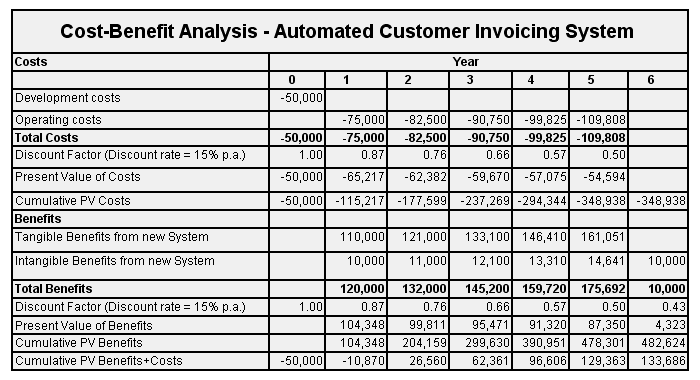Cost-Benefit Analysis
Cost-benefit analysis is used to determine the economic feasibility of a project. The total expected costs are weighed against the total expected benefits. If the benefits outweigh the costs over a given period of time, the project may be considered to be financially viable. The costs involved with a software development project will consist of the initial development cost (the costs incurred up to the point where the new system becomes operational), and the operating costs of the system throughout its expected useful lifetime (usually a period of five years). The expectation is that at some point in the system's lifetime, the accumulated financial benefits of the system will exceed the cost of development and the ongoing operating costs. This point in time is usually referred to as the break-even point.
The benefits of the new system are usually considered to be the tangible financial benefits engendered by the system. These could be manifested as reduced operating costs, increased revenue, or a combination of the two. In some cases there may be one or more less tangible benefits (i.e. benefits that cannot be measured in financial terms), but such benefits are difficult to assess. Indeed the accuracy of a cost benefit analysis is dependent on the accuracy with which the development costs, operational costs and future benefits of the system can be estimated, and its outcome should always be treated with caution.
Because money will devalue over time, it is misleading to simply directly compare future operating costs and tangible benefits with the initial cost of developing the system. A discount rate is therefore selected so that future costs and benefits can be represented in terms of their present-day value. The discount rate used is often the current interest rate used by financial markets. The future value (FV) of a sum of money invested today (the present value, or PV) at a fixed interest rate (i) for a known number of time periods (n) can be calculated as follows:
FV = PV x (1 + i)n
Conversely, we can re-arrange this equation to get the present value of a future sum of money (e.g. the estimated future costs or benefits of the proposed system) as follows:
PV = FV/(1 + i)n
Note that we have assumed here that n represents the time period in years. If the value of i represents an annual discount rate, and the time period n is measured in months, the value of i must be divided by twelve.
System development costs (C) are assumed to be incurred when the system is commissioned. Taking an expected system life of five years, the yearly benefits (B1, B2, B3, B4 and B5) are assumed to occur at the end of year one, year two, year three, year four, and year five respectively. To compute the net present value (NPV), those benefits are discounted back to their present values and added to the cost of development, C (a negative value), as follows:
NPV = C + (B1/(1+i)1) + (B1/(1+i)2) + (B1/(1+i)3) + (B1/(1+i)4) (B1/(1+i)5)
When the net present value is positive, the system has passed the break even point (i.e. it has paid for itself and justified the cost of the project).
Many organisations use the internal rate of return (IRR) to gauge the economic viability of a project. This figure is calculated by dividing the net present value (net present value benefits + net present value costs) by the present value of the total cost of the system, including the development costs and all operating costs. The following simple example demonstrates some of these principles:
Cost-benefit analysis example
A new automated customer invoicing system has been recommended for our organisation by a firm of consultants. The requirements are already known, and we now want to carry out a cost benefit analysis. The system will cost £50,000 to develop, and will have a projected useful life of five years from the time it is installed, one year from now. After five years, the system database can be transferred to the replacement system, a saving of approximately £10,000.
The current system has operating costs estimated at £100,000 per annum, whereas the annual operating costs for the new system are estimated at only £75,000. In addition, the new system has intangible benefits estimated to be worth £10,000 per annum. It is assumed that all estimates for costs and benefits will increase at a rate of 10% annually for both the current system and the new system. The organisation has set a present value discount rate of 15% per annum. The cost-benefit analysis calculations are carried out using a spreadsheet, and are shown below:

A spreadsheet can be used to perform a cost-benefit analysis
The system starts to show a positive return during its second year of operation. The internal rate of return is calculated as follows:
Cumulative PV Benefits + Costs / Cumulative PV Costs
= 133,686 / 348,938
= 0.383
This represents an IRR of 38.3% over the expected lifetime of the system, or 7.66% per year.
